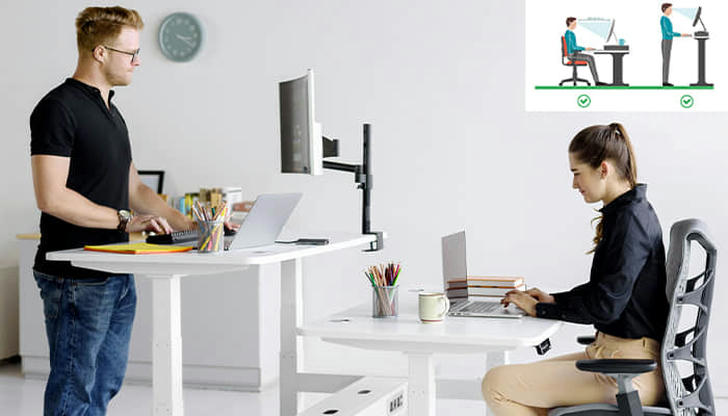Why Is Standing While Working Popular? 6 Tips to Stand Correctly Without Harming Your Body

An increasing number of office workers are opting for standing desks, which have become a symbol of better health.
The initial intention of standing desks was for weight loss and increased physical activity. However, research has found that the greatest benefit of standing desks is relieving pain and discomfort, especially for those with neck, lumbar, and back pain.
Studies show that people who sit for 8 hours a day without exercising have nearly the same risk of death as those who are obese and smoke.

Additionally, prolonged sitting is detrimental to the brain. Research has discovered that long-term sitters experience a thinning of the medial temporal lobe, a region crucial for memory. Sitting for long periods has even been linked to diseases such as dementia.
In a study led by Professor April Chambers of the University of Pittsburgh's Department of Bioengineering, a team systematically analyzed 53 studies to assess the impact of work postures on health across six dimensions: behavior time, physiological feelings, work performance, psychological feelings, discomfort, and posture. All these studies involved the use of sit-stand desks.
The results showed that for all groups, the primary benefit of standing desks is alleviating discomfort and back pain, partly because the muscles used while standing differ from those used while sitting. Moreover, standing desks do not negatively impact work performance. Employers need not worry that standing will distract employees or reduce their productivity.
However, from an overall health perspective, the benefits of standing desks are limited.
Standing desks can slightly improve heart rate, but scientists are unsure if this change has clinical significance. Additionally, there is no evidence that standing desks contribute to weight loss, body shaping, or blood pressure reduction.
How can we adjust our work habits and health through standing?
The following six tips will help you maximize the benefits of using a standing desk:
1. Change Your Position Every 30 Minutes

To maintain good health, staying active is key. Try setting an alarm to remind yourself to change your posture every 30 minutes. Alternate between sitting and standing.
2. Stand Whenever Possible

Remove chairs from meeting rooms and encourage employees to stand during meetings and discussions. Nowadays, people commonly use their phones for communication. Whether making calls or sending messages, stand up while doing so.
3. Proper Standing and Sitting Posture

When standing, keep your legs straight, tighten your abdomen, and maintain a neutral pelvis to avoid arching your lower back. When sitting, your knees and thighs should form a 90° angle. The computer monitor should be at eye level, and avoid hunching your shoulders while typing.
4. Stand for a While After Eating

Especially after lunch, standing for 10 to 15 minutes can aid digestion and help control blood sugar levels, which is particularly important for those with diabetes and those looking to prevent it. Standing after meals can also reduce afternoon fatigue, improving work efficiency and alertness.
5. Adjust Your Desk Height

Everyone's height, weight, and body shape are different. A desk that is too high can cause tension and fatigue in the shoulders and upper arms, while a desk that is too low increases neck strain. Therefore, employees should be allowed to adjust their desk height to ensure comfort, thereby enhancing work efficiency.
6. Exercise to Counteract Prolonged Sitting

Research shows that regular exercise can negate the negative effects of prolonged sitting. Even if you sit for more than 8 hours a day, exercising for 60 to 75 minutes can mitigate increased mortality risk. However, if you exercise only 5 minutes a day, the risk of early death increases by 59%. Adults are advised to engage in at least two sessions of aerobic exercise per week, each lasting 30 minutes, and to do muscle-strengthening activities every two to three days. This also helps relieve muscle tension and pain.
Whether sitting or standing, maintaining a single posture for too long is harmful to health. Different postures engage different muscles, and staying in one position for extended periods leads to excessive tension and fatigue in the associated muscles and joints.
However, if you can follow these scientific standing guidelines during work, there will be fewer health risks.

